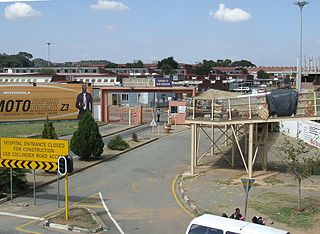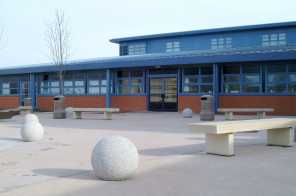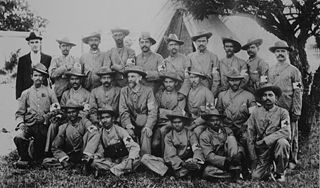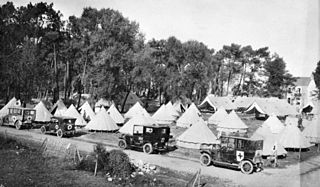
Soweto is a township of the City of Johannesburg Metropolitan Municipality in Gauteng, South Africa, bordering the city's mining belt in the south. Its name is an English syllabic abbreviation for South Western Townships. Formerly a separate municipality, it is now incorporated in the City of Johannesburg Metropolitan Municipality, and one of the suburbs of Johannesburg.

The Second Boer War, also known as the Boer War, Anglo–Boer War, or South African War, was a conflict fought between the British Empire and the two Boer republics over the Empire's influence in Southern Africa.

The First Boer War, was fought from 16 December 1880 until 23 March 1881 between the United Kingdom and Boers of the Transvaal. The war resulted in a Boer victory and eventual independence of the South African Republic. The war is also known as the First Anglo–Boer War, the Transvaal War or the Transvaal Rebellion.

The Royal London Hospital is a large teaching hospital in Whitechapel in the London Borough of Tower Hamlets. It is part of Barts Health NHS Trust. It provides district general hospital services for the City of London and Tower Hamlets and specialist tertiary care services for patients from across London and elsewhere. The current hospital building has 845 beds and 34 wards. It opened in February 2012.

Johannesburg is a large city in Gauteng Province of South Africa. It was established as a small village controlled by a Health Committee in 1886 with the discovery of an outcrop of a gold reef on the farm Langlaagte. The population of the city grew rapidly, becoming a municipality in 1898. In 1928 it became a city making Johannesburg the largest city in South Africa. In 2002 it joined ten other municipalities to form the City of Johannesburg Metropolitan Municipality. Today, it is a centre for learning and entertainment for all of South Africa. It is also the capital city of Gauteng.

The Solomon Mahlangu Regiment is a reserve infantry regiment of the South African Army.

The Johannesburg Light Horse Regiment, is a reserve armoured car reconnaissance unit of the South African Army.

Epworth HealthCare is a provider of acute medical, surgical and rehabilitation services in Melbourne, Australia. The group has four divisions: Epworth Richmond, Epworth Eastern, Epworth Cliveden, Epworth Freemasons and Epworth Geelong Epworth Rehabilitation, with rehabilitation sites at Richmond, Camberwell, Brighton and Geelong, Victoria. With over 1,200 beds and more than 7,000 staff, Epworth HealthCare is Victoria's largest not-for-profit private hospital group.

Chris Hani Baragwanath Hospital is a hospital in Johannesburg, South Africa. It is the largest hospital in Africa and third largest hospital in the world. It has 6,760 staff members, 3,400 beds and occupies 70 ha. The hospital is located in the Soweto area south of Johannesburg. It is one of the 40 Gauteng provincial hospitals, and is financed and managed by the Gauteng Provincial Department of Health. It is a teaching hospital for the University of the Witwatersrand Medical School, along with the Charlotte Maxeke Johannesburg Academic Hospital, Helen Joseph Hospital and the Rahima Moosa Mother and Child Hospital. It is an accredited Level one trauma center currently led by Trauma Surgery Consultant, Dr Riaan Pretorius. The hospital has world class trauma and emergency medicine facilities capable of all medical treatment.

University Hospital Hairmyres is a district general hospital in the Hairmyres neighbourhood of East Kilbride, South Lanarkshire, Scotland. The hospital serves one of the largest elderly populations in Scotland. It is managed by NHS Lanarkshire.

The Second Boer War was fought from 11 October 1899 until 31 May 1902, between the British Empire and the two independent Boer republics of the Orange Free State and the South African Republic. It was a lengthy war involving large numbers of troops which ended with the conversion of the Boer republics into British colonies, with a promise of limited self-government. These colonies later formed part of the Union of South Africa.

Beaufort War Hospital was a military hospital in Stapleton district, now Greater Fishponds, of Bristol during the First World War. Before the war, it was an asylum called the Bristol Lunatic Asylum, and after the war it became the psychiatric hospital called Glenside Hospital.
Wingfield Aerodrome was first the Cape Town Municipal Aerodrome, then Air Force Station Wingfield under the SAAF, before being used as a Fleet Air Arm base by the Royal Navy. After World War II, the aerodrome reverted to being the municipal airport for a while. The history of Wingfield is synonymous with the history of flight in South Africa, including pioneering attempts at commercial aviation.

The Australian Voluntary Hospital was a military hospital staffed by Australian expatriates in England that served on the Western Front between 1914 and 1916. For most of the first year of the war, although not an Australian Army unit, it was an Australian presence on the Western Front.

The Central South African Railways Class C 2-8-4T of 1900 was a South African steam locomotive from the pre-Union era in Transvaal.

6 Medical Battalion Group is a Medical Battalion in the South African Military Health Service (SAMHS). SAMHS is the fourth Arm of Service of the South African National Defence Force (SANDF).

The Transvaal Memorial Hospital for Children, based in Johannesburg, was the first dedicated children's hospital in South Africa when it opened in 1923. The hospital would remain open until 1978 when its functions were moved to the then newly opened Johannesburg General Hospital. The building is a heritage listed monument and parts of the building are currently used by community groups dedicated to the service of children.
Helen Joseph Hospital is a public hospital based in Auckland Park, Johannesburg, South Africa. Prior to 1997, it was known as the J.G. Strijdom Hospital. As a teaching hospital, its affiliated to the University of Witwatersrand's Medical School.

The Edinburgh City Hospital was a hospital in Colinton, Edinburgh, opened in 1903 for the treatment of infectious diseases. As the pattern of infectious disease changed, the need for in-patients facilities to treat them diminished. While still remaining the regional centre for infectious disease, in the latter half of the 20th century the hospital facilities diversified with specialist units established for respiratory disease, ear, nose and throat surgery, maxillo-facial surgery, care of the elderly and latterly HIV/AIDS. The hospital closed in 1999 and was redeveloped as residential housing, known as Greenbank Village.
The Tambo Memorial Hospital is a regional hospital located in Boksburg (Ekurhuleni) in Gauteng Province, South Africa.




















